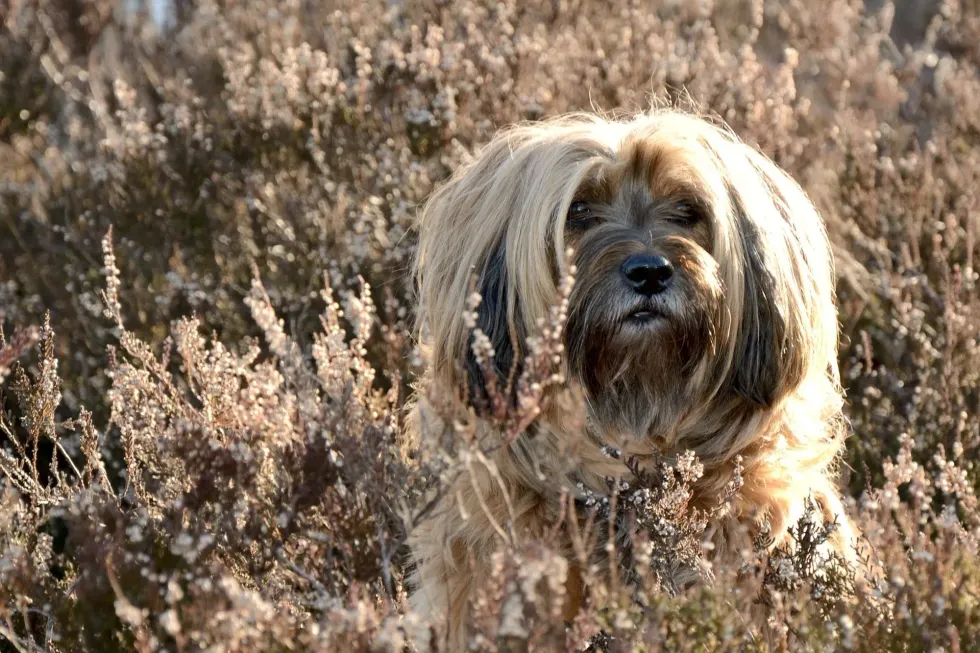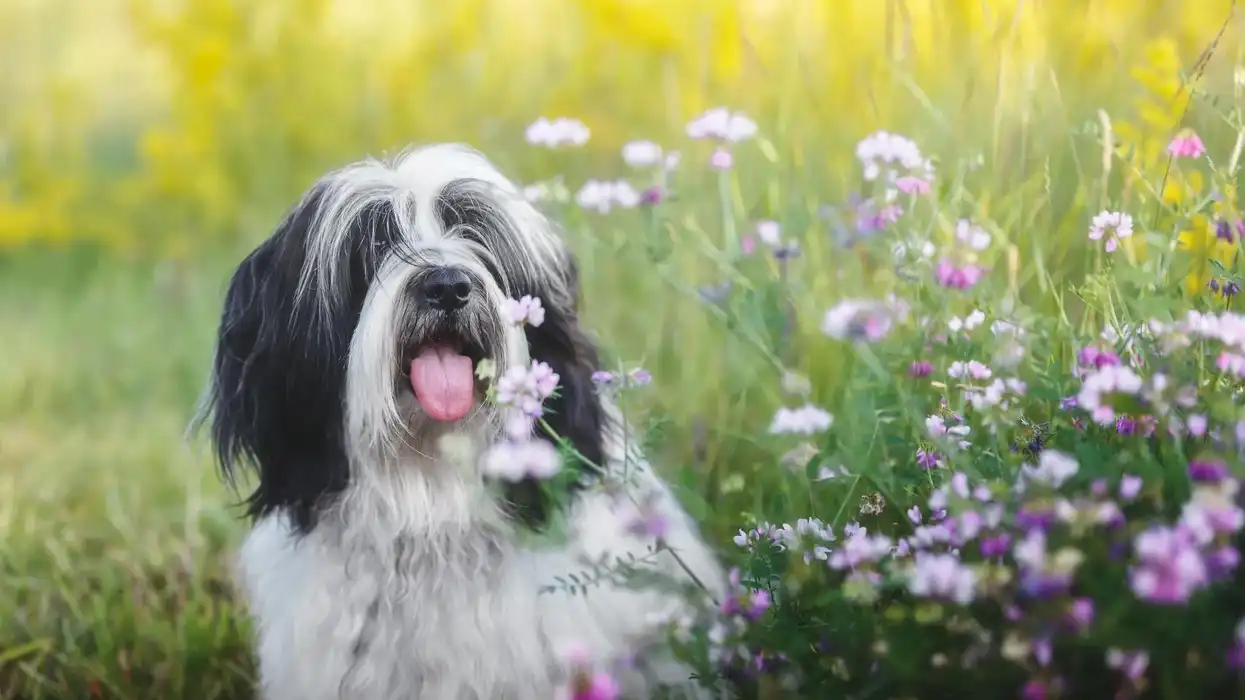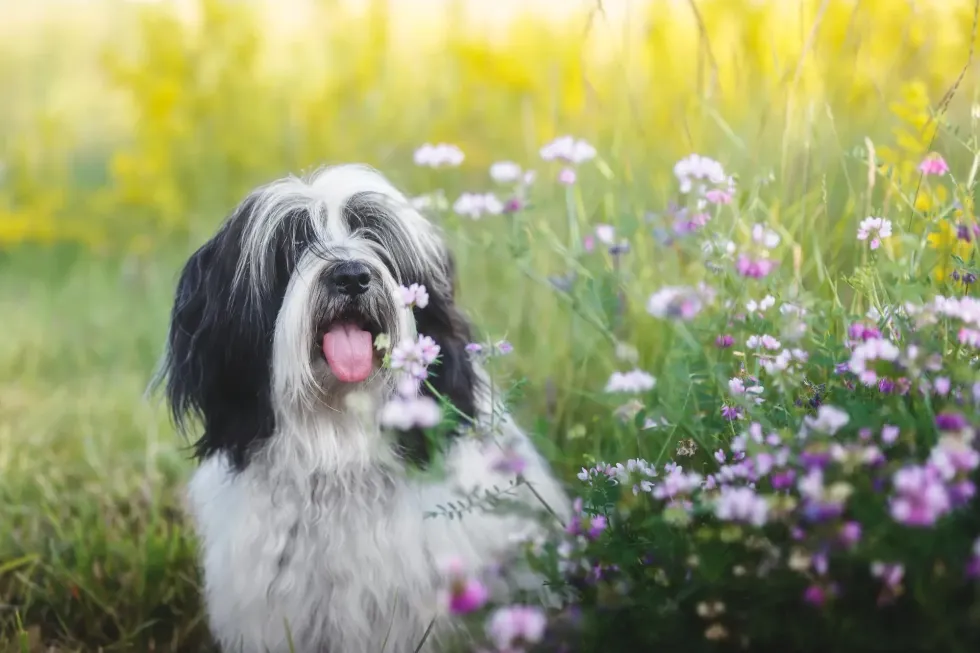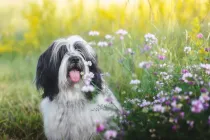Fun Tibetan Terrier Facts For Kids
The Tibetan Terrier is a domesticated dog breed. As their name suggests, these dogs originated in Tibet.
They do not belong to the Terrier group of dogs but were named for their similarities with some other terrier dogs. Their original Tibetan name is Tsang Apso. The Tibetan Terrier dog is a very affectionate, gentle, amiable, and intelligent being.
Since they were created to be companion dogs for humans, they do very well with people and families. The adult dogs are about 14-16 in (35.6-40.6 cm) tall at the shoulders and weigh about 20-25 lb (9-11.3 kg). They have a long shaggy coat of hair.
They come in many colors and patterns, like, black, white, gold, brindle, silver, and tricolor. They have drop ears and a high, curled tail, both of which are well feathered.
They also have a squarish shape. They require trimming for their long double coat.
In ancient history, these dogs are mentioned to be one of the dog breeds that the monks kept almost 2000 years ago. They are told to bring good luck. Even now, these dogs are amazing companions to humans.
For more relatable content, check out these Scottish Terrier facts and Brazilian Terrier facts for kids.
Tibetan Terrier Interesting Facts
What type of animal is a Tibetan Terrier?
The Tibetan Terrier is a type of domestic dog that originated in Tibet. However, they are not a member of the terrier group like the Australian Terrier or Norfolk Terrier and are a type of Apso dog.
What class of animal does a Tibetan Terrier belong to?
The Tibetan Terrier belongs to the Mammalia class of the Animalia kingdom. They also belong to the genus Canis of the Canidae family.
How many Tibetan Terriers are there in the world?
The exact numbers of Tibetan Terrier dogs in the world are unknown. However, they are not a very rare dog breed and you can buy them from reputable breeders.
Where does a Tibetan Terrier live?
Even though they originated from Tibet, the Tibetan Terrier has now spread through the whole world. Much like any other dog breed recognized by the American Kennel Club, these dogs can be found in households of families that adopt them or buy them from breeders.
What is a Tibetan Terrier's habitat?
The Tibetan Terrier first came into existence in the mountainous terrains of Tibet. They were companion dogs to not only ancient monks but also to herdsmen and people who lived in the mountains.
They accompanied them through hardships that they faced in the mountains and were considered a good luck charm. They were introduced in the West by Dr. Greig. Now they have become great family dogs.
They can adapt well to any lifestyle. Their thick coats make them more suited for cold weather but they do not have a problem with living in a warm place.
They like living indoor and can even adapt well to an apartment lifestyle if there is enough space for them to move around. They can laze around and be amazing family dogs. They can get bored and bark or try to escape.
But a few exercises and a walk every day are enough to keep them busy. They are described by the American Kennel Club as non-sporting family companion dogs.
Who do Tibetan Terriers live with?
Much like any other domesticated dog breed, Tibetan Terriers live with families that they are brought into. They are a very gentle and energetic dog breed that lives very well with humans. They love the company of humans and can also adapt to people quickly.
How long does a Tibetan Terrier live?
Tibetan Terriers are generally healthy dog breeds and can live up to 12-15 years.
How do they reproduce?
Like any other breed of dogs like the Poodle and Hokkaido dog, the Tibetan Terrier also breeds by mating. Female dogs usually go into heat every six months, and it may last anywhere from 18-21 days.
After male and female dogs mate with each other, the female might get pregnant. Their pregnancy lasts about 63 days but it may vary for every individual. After the gestation period is over, the mother gives birth to about five to eight puppies, the most common number of pups is six.
What is their conservation status?
Since they are not wild animals, their conservation status is not mentioned in the IUCN Red List. But since they are a domesticated dog breed that is pretty popular among dog lovers, these medium-sized dogs do not face extinction.
Tibetan Terrier Fun Facts
What do Tibetan Terriers look like?
The Tibetan Terrier is a medium-sized breed of domesticated dog. Adults of this breed are about 14-16 in (35.6-40.6 cm) tall at their shoulders and weigh about 20-25 lb (9-11.3 kg).
Their length is also similar to their height at the shoulders, which gives them a squarish silhouette. They have a shaggy and long coat. The Tibetan Terrier requires regular grooming so their hair doesn't become a burden for them.
Their fall of hair is not like other dogs as they do not shed a lot. They have a warm undercoat and a very long outer coat. This makes them best suited for cold weather.
They have long drop ears and a curly, high-set tail. Both of these are very well feathered.
They also have special padding on their paws that makes them very well equipped to walk on snow and mountains. If their coat gets too long, a fall of hair might cover up their eyes.
But they have very long lashes that stop them from getting into their eyes. They also have dark large eyes and a strong, medium-length muzzle. Their bodies are also pretty muscular and strong, making them agile.

How cute are they?
The Tibetan Terrier is a very cute breed of dog. They are not too big and not too small. They have beautiful large eyes and a very long beautiful coat. They look very cute, especially the Tibetan Terrier puppies.
How do they communicate?
They communicate mostly via barking. They are a very vocal breed. They also show affection by cuddling and playing. The Tibetan Terrier temperament is very sweet and energetic.
How big is a Tibetan Terrier?
The average height of adult Tibetan Terriers at their shoulder is 14-16 in (35.6-40.6 cm). They are a square-ish, medium-sized breed of dog.
How fast can a Tibetan Terrier run?
The exact speed of the Tibetan Terrier is not known. However, these dogs are pretty high-energy and can accompany you on small runs, walks, or jogs.
They are not very fast runners but they are happy and spirited dogs. But try not to take them out on jogs when it is too hot outside because their double coat can overheat their bodies. Instead, try giving them an exercise indoors.
How much does a Tibetan Terrier weigh?
The average weight of the adult Tibetan Terrier is 20-25 lb (9-11.3 kg), which is the breed standard weight. They are not very prone to obesity. But an unregulated and unhealthy diet can lead to weight gain. It is important to give your dog balanced, healthy and measured food every day for them to sport a healthy body weight.
What are the male and female names of the species?
Like all other dog breeds, the male Tibetan Terrier is called a dog while the female is called bitch.
What would you call a baby Tibetan Terrier?
Much like other dog breeds, the baby Tibetian Terrier is called a puppy.
What do they eat?
All domestic dog breeds need a balanced and healthy diet to keep their health intact. Good quality dog food is a must for them at least twice a day.
You can also feed them some meat and vegetables for their other nutritional needs. But you have to remember that just like people, every dog has different needs, and their food should be decided based on those needs.
If your Tibetan Terrier is more active, he will need more food than the one who is a couch potato.
Their metabolism, illnesses, and some other things also contribute to their nutritional needs. So the best option is to take your Tibetan Terrier to the vet and decide on a diet that is best for your puppy.
Are they slobbery?
They are not very slobbery. They might drool a little from time to time but Tibetan Terriers are not known for excessive drooling.
They might drool when they smell food or when they are very excited about something. But stress and other physical problems may cause your Tibetan Terrier to drool more than normal. In that case, it is a good idea to get them to a vet.
Even though generally they are a pretty healthy breed, stomach problems or dental problems may make them drool excessively. In these times it is in the best interest of your dog to take them to a vet.
Would they make a good pet?
Yes, Tibetan Terriers make for excellent pets. They might be a little loud sometimes, but barking is just how they express themselves.
They are excellent family dogs. Tibetan Terriers were initially bred to be gentle and affectionate companion dogs, and this breed still lives up to its name as a companion dog.
They do great with families as they love being close to humans. Their energy level is also pretty high, so they are good companion dogs for people who like energetic yet lazy dogs.
They are also very intelligent and easy to train. They even adapt quite well to other pets that the family might have, especially if they grew up with them.
They can also live quite well with cats.
They are gentle with children, however, since they are pretty high-energy, loud dogs, they adapt better to children of school-going age who understand the concept of having a dog in the family.
They are a little hard to groom because of their long hair, but since they do not shed too much, it is not that much of a problem.
They also can be prone to some health conditions but generally, their health is not bad. A Tibetan Terrier puppy can cost anywhere from $500-$2,500 depending on whether you are adopting them or buying them from a reputable breeder.
You can also choose to adopt a rescue adult dog. They are also a medium-sized dog breed and can adapt pretty well to an apartment lifestyle if they have some room to play around.
Did you know...
The American Kennel Club describes the Tibetan Terrier as a non-sporting, companion dog breed. They also recognized the breed in 1937.
Even though they are called terriers, they are not terriers. But they are closely related to their cousin breed, the Lhasa Apso.
The Tibetan Terrier was considered to be a holy dog by the people of ancient Tibet. It was considered to be a sin to sell them because they were thought to bring good luck, so they were never sold, only gifted.
The first Tibetan Terrier was brought to the West by Dr. Agnes Greig.
You can adopt a rescue dog or you can also get a Tibetan Terrier puppy from a good breeder.
They are a healthy breed but can be prone to some health problems like lens luxation, retinal atrophy, canine hip dysplasia. But regular visits to the vet will keep your dog from getting too sick. They have some genetic health issues but they are not too bad.
Is Tibetan Terrier a good family dog?
Yes, Tibetan Terriers make for excellent family dogs. The breed was created to be companion dogs to humans. They have a very gentle and affectionate temperament. They also get along pretty well with children and strangers.
They can also adapt well to other pets. They are energetic and intelligent, and they love being around humans. They might tend to bark a lot but that is just a characteristic behavior of this breed.
Can Tibetan Terriers be left alone?
No, Tibetan Terriers do not deal very well with being left home alone. They have separation anxiety that makes them very nervous when there are no humans around them. They feel calm and safe in human company. If they get bored or anxious, they will bark a lot and might even try to escape.
Here at Kidadl, we have carefully created lots of interesting family-friendly animal facts for everyone to discover! For more relatable content, check out these collared pika interesting facts and Alaskan Husky fun facts pages.
You can even occupy yourself at home by coloring in one of our free printable Tibetan Terrier coloring pages.
We Want Your Photos!
More for You
See All
Bachelor of Arts specializing in Journalism and Mass Communication, Postgraduate Diploma in Sports Management

Moumita DuttaBachelor of Arts specializing in Journalism and Mass Communication, Postgraduate Diploma in Sports Management
A content writer and editor with a passion for sports, Moumita has honed her skills in producing compelling match reports and stories about sporting heroes. She holds a degree in Journalism and Mass Communication from the Indian Institute of Social Welfare and Business Management, Calcutta University, alongside a postgraduate diploma in Sports Management.
Disclaimer
1) Kidadl is independent and to make our service free to you the reader we are supported by advertising. We hope you love our recommendations for products and services! What we suggest is selected independently by the Kidadl team. If you purchase using the Buy Now button we may earn a small commission. This does not influence our choices. Prices are correct and items are available at the time the article was published but we cannot guarantee that on the time of reading. Please note that Kidadl is a participant in the Amazon Services LLC Associates Program, an affiliate advertising program designed to provide a means for sites to earn advertising fees by advertising and linking to Amazon. We also link to other websites, but are not responsible for their content.
2) At Kidadl, we strive to recommend the very best activities and events. We will always aim to give you accurate information at the date of publication - however, information does change, so it’s important you do your own research, double-check and make the decision that is right for your family. We recognise that not all activities and ideas are appropriate for all children and families or in all circumstances. Our recommended activities are based on age but these are a guide. We recommend that these ideas are used as inspiration, that ideas are undertaken with appropriate adult supervision, and that each adult uses their own discretion and knowledge of their children to consider the safety and suitability. Kidadl cannot accept liability for the execution of these ideas, and parental supervision is advised at all times, as safety is paramount. Anyone using the information provided by Kidadl does so at their own risk and we can not accept liability if things go wrong.
3) Because we are an educational resource, we have quotes and facts about a range of historical and modern figures. We do not endorse the actions of or rhetoric of all the people included in these collections, but we think they are important for growing minds to learn about under the guidance of parents or guardians.







